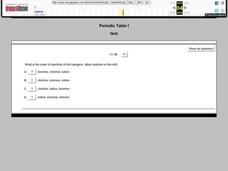Curated OER
Corrosion & Rust
Students examine how and when rust and corrosion occur. In this corrosion lesson students complete an experiment to see why metals rust.
Curated OER
Electronegativity
Young scholars identify the type of bonding between two atoms of elements given their electronegativity values. They study the trend of electronegativity across the periodic table in small groups.
Curated OER
How to identify a physical change from a chemical change
Learners identify the difference between some physical and chemical properties and compare some physical and chemical changes. They design an experiment to distinguish between a physical or a chemical property of their choice.
Curated OER
Teaching Avogadro's Number
High schoolers design an experiment to determine Avogadro's number. Students utilize an ammeter, an electrolytic cell and internet research.
Curated OER
How Can we Measure the Rate of a Chemical Reaction?
Students examine different types of chemical reactions. They explore how alcohol molecules affect the reaction rates. They answer discussion questions to end the lesson.
Curated OER
The Conceptual Theory of Chromatography
Students conduct a lab to determine the best way to separate a variety of mixtures choosing between paper, thin layer and column chromatography. They use chromatography techniques to identify unknown substances and submit a lab report on...
Curated OER
How Are The Properties of Covalent Compounds Influenced By Chemical Bonding?
Students work together to observe the bond lengths of single, double and triple bonds. They make their own predictions about the strength of the bonds and chemical reactions. They answer discussion questions to complete the lesson.
Curated OER
Measuring Thermal Energy Transfer
Students conduct an experiment to calculate and quantify heat transfer. They conduct the experiment, and complete a data and lab conclusion sheet.
Curated OER
Investigating the Shapes of Covalent Molecules and Measuring their Respective Bond Lengths and Bond Angles
High schoolers will draw Lewis structures of common covalent compounds using a Chem 3D computer program. They will predict the shapes of the molecules, complete a data table, and formulate rules for predicting shapes of molecules. In the...
Curated OER
The Synthesis of Some Organic Compounds And Their Representative Structures
Students examine how to represent organic compounds three-dimensionally. They write a synthesis reaction for three demonstrations, and construct a three-dimensional structure using a molecular modeling set.
Curated OER
Acid-Base Indicator Paper
Middle schoolers are able to prepare and use pH indicators in paper form. They find out the color of the indicator paper plus test solution may change with time. Students use red cabbage to use for the indicator.
Curated OER
Activity #5 Environmental Effects
Pupils explain the implications of particle theory of The Law of Conservation of Matter for problems of pollution and waste disposal. They describe, in terms of atoms and molecules, what happens to materials when they are dissolved or...
Curated OER
Activity #15 The Snowy Christmas Tree
Middle schoolers weigh out the proper amount of silver nitrate and prepare the silver nitrate solution. They observe what occurs when pure copper is added to silver nitrate solution. Pupils determine whether the change in the appearance...
Curated OER
Activity #18 Decompostion of Baking Soda
Pupils observe what occurs as baking soda is heated. They explain why a chemical rather than a physical change occurred during the procedure. Pupils identify the tpe of reaction (decomposition). Students conduct a glowing splint test...
Curated OER
Activity #19 Oxygen For Yeast
Students observe and record what occurs when yeast is added to hydrogen peroxide. They indicate why a chemical reaction (decompostion) must have occurred during the experiement. Pupils explain why yeast was used. Students comprehend the...
Curated OER
Periodic Table I Quiz
In this periodic table I quiz, students select the best answer to the given questions. Students apply their knowledge of the periodic table and the arrangement to correctly answer the questions presented.
Curated OER
Elements
In this elements worksheet, students give the symbol for given elements. Students determine the number of protons, electrons, and neutrons for atoms. This worksheet has 9 fill in the blank and 5 problems to solve.
Curated OER
Organic Compounds
In this organic compounds worksheet, students practice identifying chemical structures and compare sugars, starches, and lipids. This worksheet has 5 matching and 15 multiple choice questions.
Curated OER
Chemical Compounds
In this chemical compounds worksheet, students identify the types of intermolecular forces present in the given substances, calculate the heat required to convert a liquid to gas, and explain the ideal-gas law. This worksheet has 5...
Curated OER
Making Ammonia - The Haber Process
In this fertilizer worksheet, high schoolers read background information about how farmers began using nitrogen compounds as fertilizer and how Fritz Haber came up with an efficient process. Students complete 10 short answer questions...
Curated OER
Air Pollution
In this pollution worksheet, learners read about how air pollution is created and the harmful products that come out of a car exhaust. Then students complete 9 short answer questions.
Curated OER
Cabbage Juice Indicator
Middle schoolers experiment with household solutions and classify them as a base or acid. For this exploratory lesson students complete a lab where they test products to see if they are an acid or a base.
Curated OER
Thermoset Polymers
Students complete a lab activity with polymers to allow them to better understand how to make "observations". In this science lesson students make measurements and collect data.
Curated OER
Coasts
Students explain the different types of marine coasts and where they are located in the United States and its territories. They explain and identify some of the life forms that inhabit different marine coastal regions.
Other popular searches
- Lake Water Chemistry
- Water Chemistry Ions
- Co2 Water Chemistry
- Water Chemistry Lesson Plans
- Ocean Water Chemistry
- Basic Water Chemistry
- Water Chemistry Properties
- Storm Water Chemistry
- Marine Water Chemistry
- Size vs. Water Chemistry
- Chemistry of Water
- Water Chemistry Nitrate

























